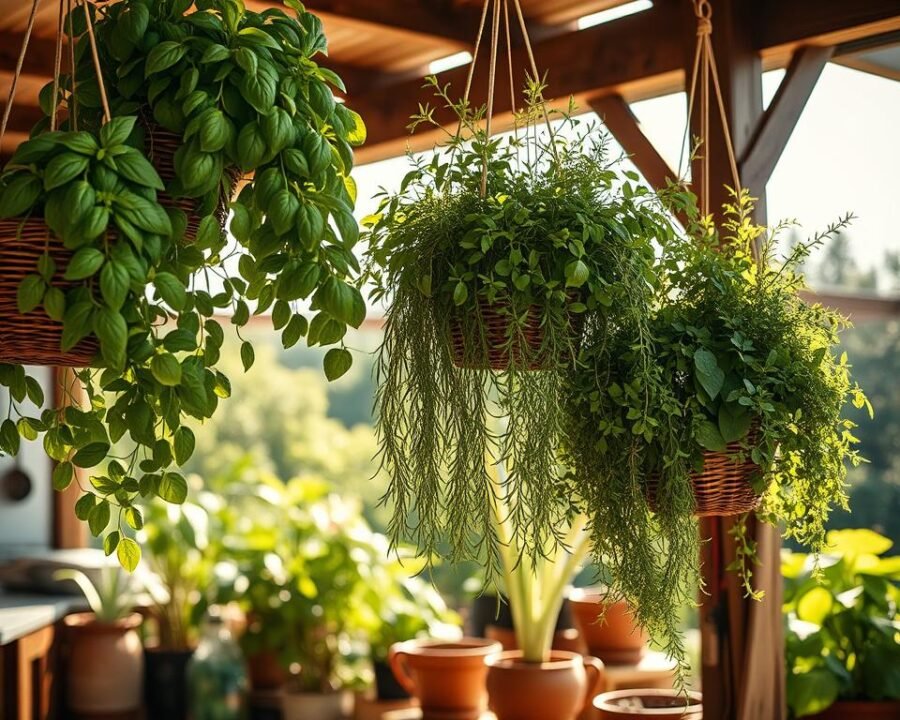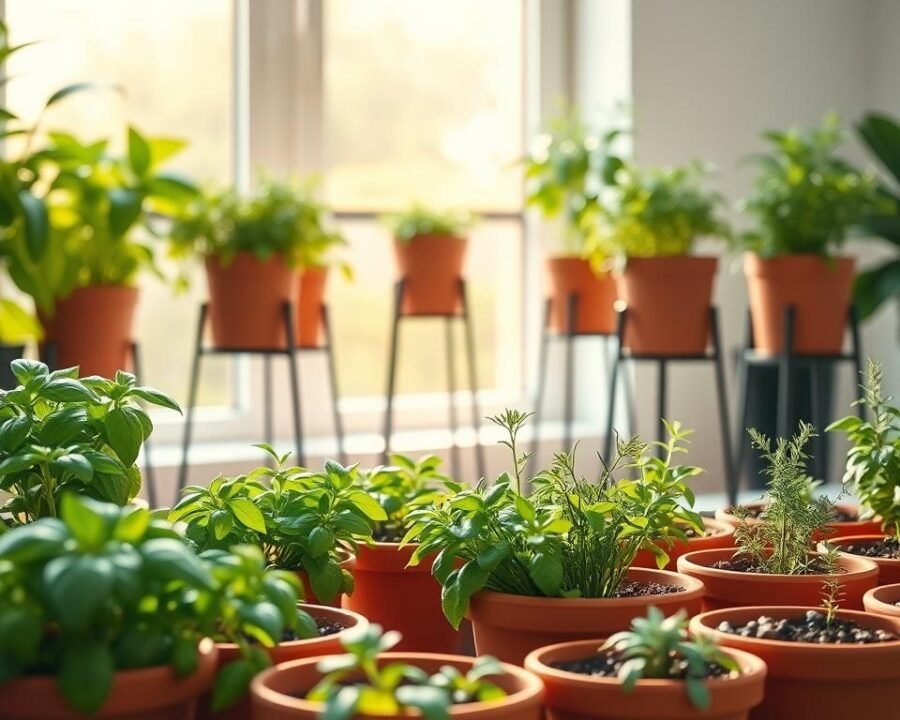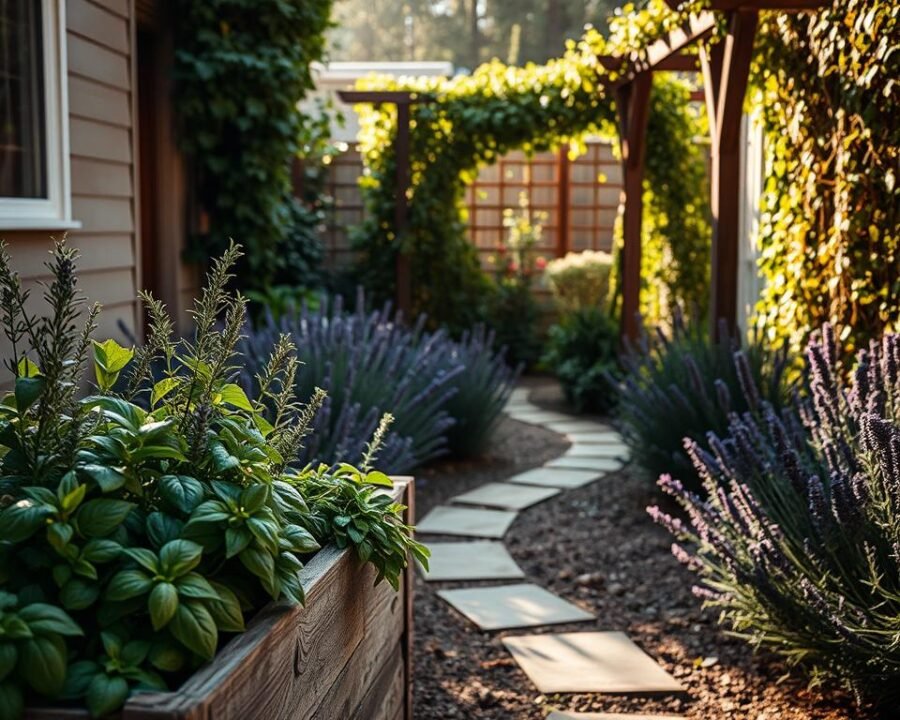There’s something magical about plucking fresh herbs right from your home. Whether you live in a cozy apartment or a bustling urban loft, a hanging herb garden brings nature indoors without sacrificing precious space.
Imagine stepping into your kitchen and snipping fragrant basil or mint for tonight’s dinner. These plants thrive in small areas, making them perfect for balconies or even sunny windowsills. Plus, they’re beginner-friendly—chives and thyme practically grow themselves!
Vertical gardens add charm while maximizing room. No backyard? No problem. Many city dwellers enjoy fresh flavors year-round with minimal effort. It’s a simple way to elevate meals and brighten your living space.
Key Takeaways
- Fresh herbs enhance meals and fit small living areas.
- Vertical designs save space while adding aesthetic appeal.
- Low-maintenance options like basil are ideal for beginners.
- Year-round access to homegrown flavors boosts cooking creativity.
- Perfect for apartments, patios, or sunny indoor spots.
Why a Hanging Herb Garden Is the Perfect Project for You
Skip the grocery aisle and harvest herbs right from your kitchen. Store-bought bundles often wilt quickly, but a herb garden offers fresh flavors year-round. Plus, 82% of beginners succeed—it’s easier than you think!
Compare costs: A $3 store-bought basil plant lasts a week. For the same price, seeds grow months of harvests. One-time investments like pots or soil pay off fast.
Gardening isn’t just practical—it’s therapeutic. Digging your hands into soil reduces stress. Studies show it boosts mood and creativity. Imagine snipping mint for tea after a long day.
Short on space? Vertical designs fit balconies or windowsills. No yard needed. Renters love it—no permanent changes, just fresh flavors on demand.
Maintenance is a breeze. Water and sunlight take 15 minutes daily. Even busy schedules can handle it. Less grocery trips mean more time for what matters.
- Save money: Grow $50 worth of herbs for $10.
- Boost well-being: Gardening lowers stress levels.
- Maximize small spaces: Perfect for urban living.
- Quick care: Less effort than weekly shopping.
Ready to ditch store-bought herbs? This project fits any lifestyle. Fresh, flavorful, and fulfilling—all from home.
Gathering Your Materials: What You’ll Need
Starting your DIY project requires just a few key materials. With a $45–$75 budget, you can build a durable setup that lasts for years. Let’s break down the essentials.
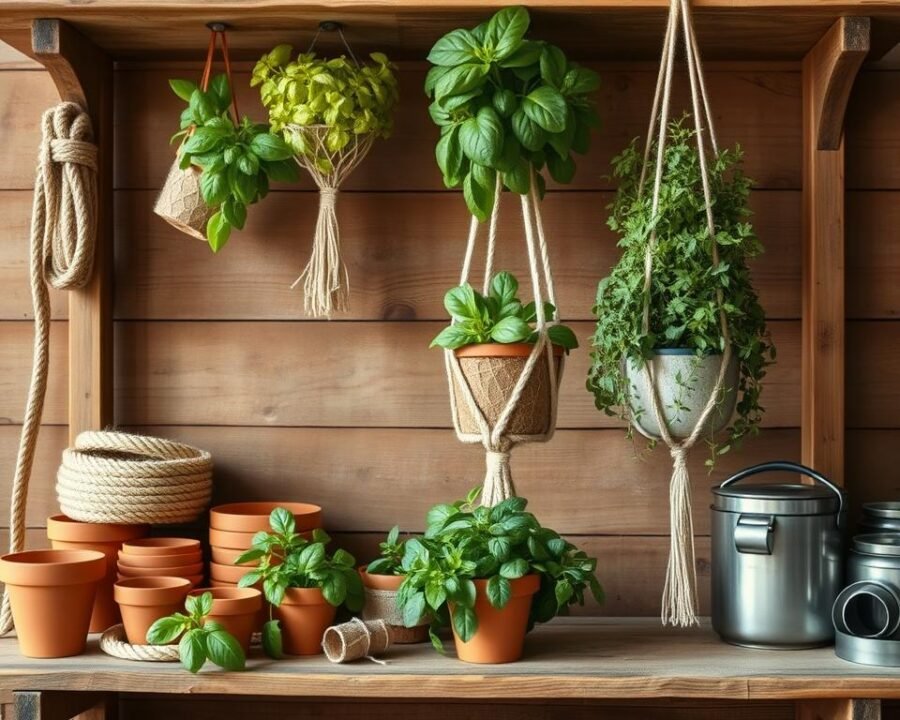
Essential Tools for the Job
Grab these tools to streamline construction:
- Jigsaw: Cuts boards to size.
- Orbital sander: Smoothes rough edges.
- Speed square: Ensures precise angles.
- Drill: Creates holes for rope and screw placement.
Materials to Build Your Garden
Choose weather-resistant options for outdoor use:
- 1x6x8 boards: Cedar resists rot; pine is budget-friendly.
- ¼” rope: Supports weight without stretching.
- Minwax Polycrylic: Protects wood from moisture.
- Zip ties: Reinforce the frame during assembly.
Pro tip: Wrap rope ends with painter’s tape to prevent fraying. For pots, clay offers better drainage, while plastic is lightweight. Use a level to ensure even hanging at home.
Step-by-Step: Building Your Hanging Herb Garden
Transform raw materials into a functional design with precision. This guide breaks down each step to ensure stability and style. Grab your tools—let’s create a space-saving masterpiece.
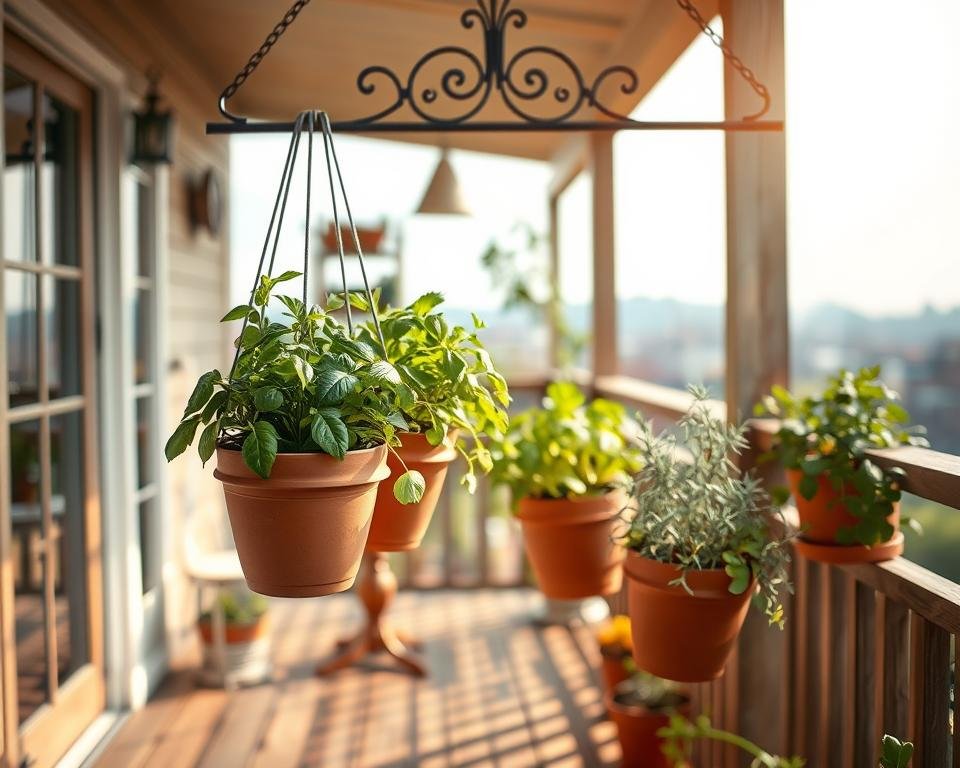
Step 1: Cutting and Preparing the Boards
Measure and mark boards to 32″ lengths using a speed square. Cedar resists rot, while pine offers affordability. Sand edges smooth to prevent splinters.
Pro tip: Use painter’s tape on cut lines to reduce wood tear-out. For balconies under 4 feet wide, adjust lengths to 24″.
Step 2: Drilling Holes for Rope and Pots
Drill ¼” holes 1″ from the sides and ½” from the ends. A string compass helps mark perfect circles for pot placement.
- Safety first: Wear goggles and secure the board with clamps.
- For heavy pots, widen holes to ⅜” for thicker rope.
Step 3: Assembling the Frame with Rope and Zip Ties
Thread rope through holes, spacing shelves 10″ apart. Secure joints with zip ties for extra stability. Check with a level before hanging.
“Weight distribution matters—place heavier plants at the base.”
Reinforce the frame by doubling zip ties at stress points. Test durability by gently tugging each shelf.
Choosing and Planting Your Herbs
Nothing beats the aroma of freshly picked greens right at your fingertips. The right selections ensure a lush, productive setup. Let’s explore top performers and pro planting strategies.
Top Picks for Vertical Growth
Basil, thyme, oregano, and mint thrive in elevated setups. These plants adapt well to confined spaces and offer robust flavors. Basil loves warmth, while mint spreads quickly—ideal for trailing designs.
Group by sunlight needs:
- Full sun (6+ hours): Rosemary, sage, lavender.
- Partial shade: Parsley, chives, cilantro.
Smart Planting Techniques
Use pots with drainage holes to prevent root rot. Fill them with 6–8″ of quality soil for strong roots. For nursery starts, loosen roots gently before transplanting.
Pro tip: Pair basil with tomatoes—they deter pests naturally. Harvest outer leaves first to encourage continuous growth. For seed starters, keep soil moist until sprouts appear.
“Stagger planting every two weeks for a non-stop harvest all summer.”
Trailing varieties like creeping thyme spill beautifully over edges. Keep them trimmed to maintain shape and airflow. With these tips, your fresh herbs will flourish effortlessly.
Caring for Your Hanging Herb Garden
Fresh flavors stay vibrant with proper watering and seasonal adjustments. A thriving setup rewards you with aromatic leaves for cooking and teas. Here’s the way to keep plants lush all year.

Watering and Sunlight Needs
Herbs love consistency. Water every 2–3 days in summer, ensuring soil stays moist but not soggy. Morning is the ideal place to hydrate—leaves dry before evening, preventing mold.
Match sunlight to plant preferences:
- Basil and rosemary: 6+ hours of direct light.
- Parsley and mint: Thrive in dappled shade.
“Group pots by light needs to simplify care. Rotate weekly for even growth.”
Seasonal Maintenance Tips
Protect fresh herbs from frost with burlap covers or move pots indoors. In spring, prune dead stems to encourage bushier growth. For perennials like thyme, mulch roots before winter.
Try these seasonal hacks:
- DIY drip irrigation: Use recycled bottles with small holes.
- Organic fertilizer: Blend banana peels and eggshells into soil.
- Microclimate maps: Track sun patterns in your USDA zone.
With these steps, your garden stays productive through every season.
Conclusion: Enjoy Your Best Hanging Herb Garden
Growing herbs at home brings joy and flavor to everyday life. With 94% of beginners loving their results, it’s a rewarding way to enhance meals and brighten any space.
Share the harvest by gifting cuttings or hosting planting parties. Expand your setup with strawberries or flowers for variety. Snap progress photos and tag friends—gardening thrives on shared inspiration.
Every snip of basil or thyme marks growth, both in your garden and skills. Start small, experiment often, and savor the journey. Fresh flavors and green places await—just dig in!
